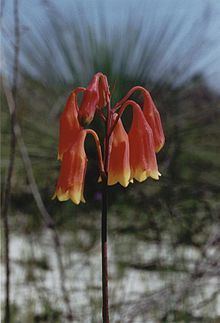Clade Monocots | Clade Angiosperms Genus Blandfordia Rank Species | |
 | ||
Similar Blandfordia, Blandfordia nobilis, Blandfordiaceae, Blandfordia punicea, Ceratopetalum gummiferum | ||
Blandfordia grandiflora is a species of flowering plant native to south-eastern Australia. B. grandiflora is commonly known as the large Christmas bell because it generally flowers in December and January. It is a perennial herb, and has tubular, bell-shaped flowers. It is one of only four Blandfordia species.
Contents
Taxonomy
Blandfordia grandiflora belongs to the family Blandfordiaceae, and the genus Blandfordia. In 1810, Robert Brown collected samples of B. grandiflora from near the Hunter River in Australia and named them, although it is thought that he did not name the plant we consider today to be B. grandiflora. The name Blandfordia honors the Marquis of Blandford and the name grandiflora means "large flowered". Of the four species of Blandfordia, B. grandiflora is considered the most robust, so the name grandiflora suits the plant. At one time, B. grandiflora went by the name B. flammea.
Description
It is an herbaceous plant (a seed-producing perennial that does not develop woody tissue, but at the end of a growing season, dies down)
B. grandiflora is a grass-like plant with narrow leaves and tubular, bell shaped flowers. Most of the flowers are red with yellow tips, although it is possible to see an all-yellow flower as well. The flowers grow in clusters of 3 to 9 at the top of the stem. The flowers grow to be 5 centimeters in length. The stems are 30 to 60 centimeters long, although another description suggests that the flowering stems (scapes) usually grow up to 80 cm in length but can reach 175 cm. Although well-established in cultivation, B. grandiflora is currently considered an endangered species in Queensland.
Reproduction
Blandfordia grandiflora is a self-fertilizing plant. This means that fertilization of the plant can be achieved by its own pollen or sperm. Self-fertilization is not synonymous with self-pollination (can achieve pollination without and external pollinator) which means that B. grandiflora is still dependent on external pollinators. The flowers produce nectar which attracts honey-eating birds to B. grandiflora. After three months of flowering, the seeds ripen. The seeds are contained in papery pods. B. grandiflora is a slow germinating plant, so the seeds will take a long time to grow.
Cultivation
Although Blandfordia grandiflora is only native to Australia, in the nineteenth century, many botanists grew it in Great Britain because it can easily be grown as a potted plant. B. grandiflora grows well in sandy soils. The wet coastal heaths of Australia, such as, New South Wales and Queensland have the sandy soil necessary for B. grandiflora to grow. In order for B. grandiflora to grow, the soil should be light and well-drained and B. grandiflora should not be in direct sunlight or in heavy shade. B. grandiflora is a very slow growing plant, so more aggressive plants easily swamp it in the wild.
